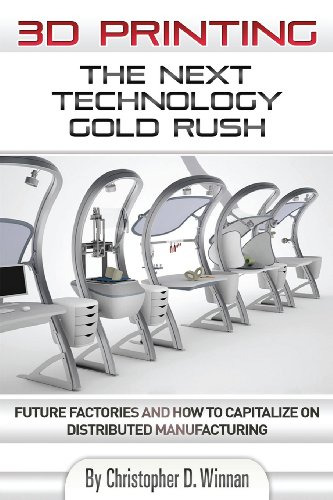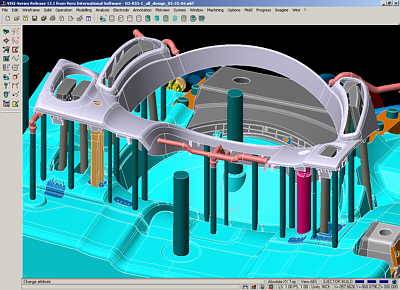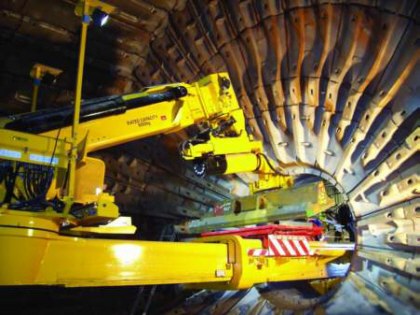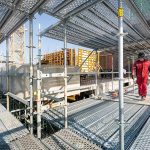BEGNEAUD Manufacturing, Inc. combines vision with high-tech equipment and 3D CAD to push the envelope in sheet metal design and fabrication
To better harness the innovative thinking of its workforce and the capabilities of its high-tech machinery, BEGNAUD Manufacturing, Inc. needed to upgrade from 2D AutoCAD.
Maybe it was the time he had to ponder his future during the long bike rides to school, or maybe it was simply the unfettered imagination of youth, the impetus doesn’t matter much now. But ever since Don Begneaud founded BEGNEAUD Manufacturing, Inc. the company has been driven by a strong entrepreneurial vision. The company has continually invested in the latest machine and design technology to retain and strengthen its position as one of the leading sheet metal fabricating companies in the United States. Don realized early on that if he could combine cutting-edge equipment and technology with a culture that encourages and rewards innovative thinking, he would have a company that could be successful in any market. BEGNEAUD invests in only the best sheet metal cutting and forming equipment from the high-tech machinery manufacturer TRUMPF. To get the most out of this industry-leading equipment, the company realized it needed to move from 2D CAD to 3D. Here too, the company searched for the best, selecting Solid Edge from UGS as its 3D design solution.
Don began selling his welded art at various art shows in Lafayette and Lake Charles at the age of 14. By the time he was a student in college, he had founded BEGNEAUD and was peddling the above-mentioned bicycle to school while his lone employee drove Don’s truck to each day’s jobsite. The company has grown from its modest and rather unique beginning to become one of today’s most innovative sheet metal fabricating companies. Located in Lafayette, Louisiana, BEGNEAUD employs 50 plus people who are encouraged to think “outside the box” and offer suggestions for increasing efficiencies within the company as well as tweaking customers’ designs to maximize product performance and minimize manufacturing costs.
3D CAD drives high-end equipment
The company relies on Solid Edge to help it get the most out of its high-tech machines and capitalize on the competitive edge that the machinery provides. Because AutoCAD 3D was extremely cumbersome, BEGNEAUD began reviewing a number of 3D CAD systems. BEGNEAUD made the decision to go with Solid Edge in 1997 because it was particularly user-friendly. The ability to draw something in 3D and then create into a flat was very simple because of the superior sheet metal environment included in the software. “Solid Edge included specialized tools for sheet metal design and SolidWorks didn’t,” says Bryan Lagrange, CAD supervisor for BEGNEAUD. “For example, the tool bar in the Solid Edge sheet metal environment makes it possible to quickly select sheet metal-specific features and drop them right into a design. With SolidWorks we would have had to first create the features we wanted and then drag them into a part drawing.” The company also realized Solid Edge would integrate better with its manufacturing processes. “With Solid Edge we saw how easily we could control sheet metal construction, such as how we flatten certain features of a part,” says Lagrange. “Solid Works didn’t offer us this control.”
The advantages of Solid Edge coincided with the company’s reputation for quality and innovation. Using the tools in Solid Edge to control bend lines, for example, allows the company to maximize the performance of its high-tech TRUMPF forming and cutting machines. And that translates into a huge quality advantage. “Once we’ve made a part for a customer, we can offer an unmatched ability to repeatedly hold tight tolerances so that our customers get the exact same part order after order,” adds Lagrange. “This consistency has led to our recognition as a leader in the sheet metal fabrication industry. And, being recognized as one of the best in our field has allowed us to service a diverse group of industries.”
3D pleases customers, slashes prototyping costs The transition to 3D modeling has allowed the company to offer superior customer service as well. When a recent customer sent out an image for a telephone box for bid to several fabricators, BEGNEAUD was able to meet the customer’s requirements for aesthetics, quality, manufacturability and cost. More importantly though, by virtually modeling the part in 3D, BEGNEAUD CAD specialists were able to improve upon the design and make the box less expensive to produce. “Working in 3D we were able to eliminate costly welds of the original design, and the subsequent required steps of finishing the welded surfaces. This enabled us to reduce manufacturing costs of the part,” states Lagrange.
CAD specialists also used 3D modeling on this project to check for part interferences by creating a virtual assembly in Solid Edge. This reduced the number of prototypes needed to verify manufacturability. “In 2D we would have had to make several physical prototypes to refine the design and recheck our design changes,” Lagrange explains. “With 3D modeling we had the improved design verified in a couple of hours. In 2D it would have taken us four times as long to verify the design with physical mock-ups.”
This reduction in prototypes occurs on every project. By virtually modeling sheet metal designs in Solid Edge, Lagrange estimates the company has cut the number of prototypes in half. “We still make prototypes,” says Lagrange. “The difference is that by working in a virtual environment we can verify that the first prototype will be correct before ever going into metal. By working in 3D, we can eliminate design errors that we couldn’t see in 2D until we actually made the part.”
With material prices skyrocketing, 3D modeling has given BEGNEAUD another competitive advantage in being able to eliminate waste. When designing a structural canopy for the local university’s college of art, for instance, the company slashed 50 percent from the wasted material it would have had if it had designed the structure in 2D. “Working in 3D, we were able to avoid much of the leftover material by matching the design with stock material sizes, explains Lagrange. “The design was so complex that there’s no way we could have done that in 2D. This ability to maximize material usage saves our customers money and makes us more competitive.”
A shining example of how BEGNEAUD combines its culture of innovation with its high-tech capabilities is the company’s “Enclosure Generator” developed by Lagrange. The company manufactures many different sized, but similarly featured, electrical enclosures. Lagrange capitalized on Solid Edge’s compatibility with Microsoft products to create a program that has reduced enclosure design time drastically. Users simply input data for height, length, width and material thickness. “Before we had Solid Edge, we were designing each enclosure from scratch,” says Lagrange. “Now we just input the size parameters of an enclosure and we have the design in about five minutes. In 2D it took about a day to design the same enclosure.” True to its spirit of recognizing innovation, the company presented Lagrange with a Major Achievement Award for the Enclosure Generator.
From its humble beginnings of a young man on his bicycle to its reputation today as a leading sheet metal fabricator on the cutting edge of technology, BEGNEAUD is a stellar example of how far a true entrepreneurial spirit can take a company in today’s competitive business environment. With Solid Edge enhancing the company’s ability to produce products as diverse as sculpted artwork to high-tech aerospace components, there isn’t an industry that uses sheet metal fabrications that can’t benefit from the innovative, forward-looking approach BEGNEAUD takes in solving its customer’s requirements.
www.begno.com
www.solidedge.com>







